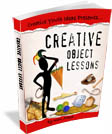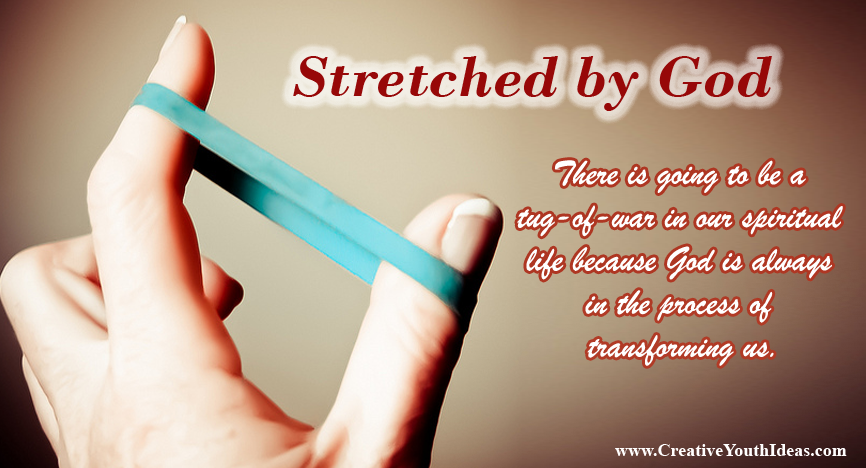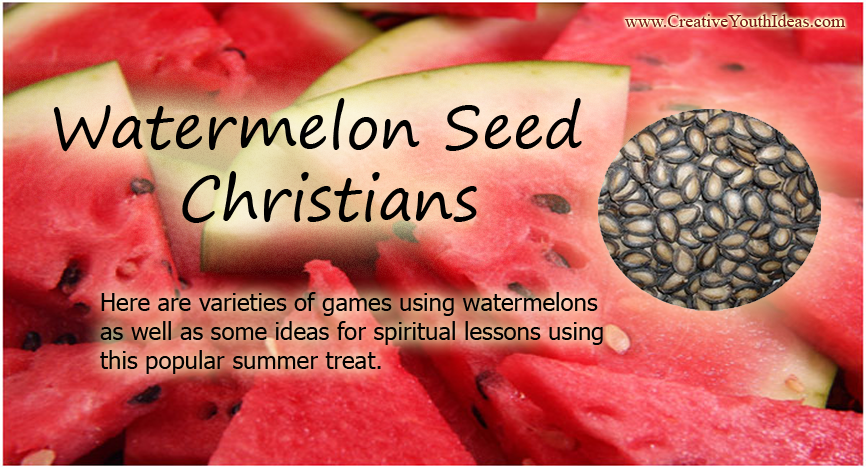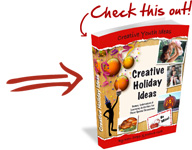There is going to be a tug-of-war in our spiritual life because God is always in the process of transforming us. Change causes tension and we are stretched. This week’s lesson uses rubber bands for games and as an object lesson on the topic of being stretched by God.
PLEASE SHARE THIS IDEA ON FACEBOOK – CLICK HERE
Rubber Band Games
- Rubber Band Face – Youth compete by stretching a rubber band over their heads and open their mouths so that the rubber band is stretched between their teeth and below their ears. Without using their hands, they must move the rubber band down their faces so that it ends up around their neck. They will need to use their tongue, lips and teeth and lots of chin wriggling to make this happen. be sure to have a camera because the distorted faces are hilarious. (You can also place the rubber band on the upper lip just below the nose for a different variation)
- Rubber Band Face – Youth compete by stretching a rubber band over their heads and open their mouths so that the rubber band is stretched between their teeth and below their ears. Without using their hands, they must move the rubber band down their faces so that it ends up around their neck. They will need to use their tongue, lips and teeth and lots of chin wriggling to make this happen. be sure to have a camera because the distorted faces are hilarious. (You can also place the rubber band on the upper lip just below the nose for a different variation)
- Rubber Band War – Set up two fortresses in a classroom using folding tables turned on their sides about 8-10 feet apart. Put a line of masking tape down the middle of the playing field between the two tables. Give two teams tons of rubber bands (you can buy them by the bag at office supply stores). Teams try to hide behind the fortress, but can jump out and run around as long as they stay on their side of the dividing line. If anyone gets shot by a rubber band, even from their own team, they are out of the game. The last team standing (or crawling around the floor) wins. Rubber bands must be shot directly in order to get a person out. Simply tossing them over the table doesn’t count. Stress the importance of honesty. Try different configurations with your tables to keep it interesting. Use thin rubber bands so they don’t hurt too much or cause injuries.
- Rubber Band Targets – Hang aluminum pie tins from string across one end of the room. Use a marker to label them with different point values. When hit with a rubber band they will make a definite sound. Give each youth 5 to 10 rubber bands to shoot from the other side of the room. Highest score wins.
- Rubber Band Pass – The objective of this youth group game is to pass the most rubber bands to the end of your team’s line as possible in a given amount of time. Divide into teams and give every team member a plastic drinking straw to place in his or her mouth. (You can also use dried spaghetti in place of a straw) Once the straw is in the mouth you cannot adjust it or touch it with your hands. The first person on each team places a rubber band on his or her straw, then using the straws only must pass it to the second person in line, and continue until it reaches the end of the line. Only one rubber band can be on a straw at a time.
- Rubber Band Man – You’ll need a lot of rubber bands for each team. Give each team 1 minute to place as many rubber bands as possible on their rubber band man (or woman). A rubber band on the rubber band man’s hands or arms is worth 1 point. The feet and legs are two points. Face is 3 points. Hanging it on the ears doesn’t count. The neck is not allowed. The team with the most points wins. Use different size rubber bands to make the game more interesting. Be prepared for some outrageous photos.
- Rubber Band Rope Jumping – Loop a number of rubber bands together tightly until you have a larger one (You can select the length you want). Teams then compete to see who can make the most jumps using the rubber band.
- Loop Groups – Tie a number of rubber bands together to form a big loop about the size of a hula hoop. Ask the youth to stand in a circle and hold hands. Then have one pair of youth release their hands and reach through the loop circle and then re-connect hands. The ring of rubber bands must travel in a clockwise direction and return to the initial starting position without anyone letting go of the hands on either side of them. The youth must stay in one location while the rubber band loop moves around the circle. Fastest time wins.
- Rubber Band Limbo – This game, is like the traditional game of limbo, except that the string of rubber bands replaces the pole. The rubber bands are stretched at progressively lower levels and the youth try to pass under it.
- Rubber band wrestling – This game is played between pairs of youths. They must sit at a table facing each other, and resting their right hands on the table. They then hook their fingers together with their thumbs raised up in the air. A rubber band is then placed around the two thumbs. On “go” they each try to capture the rubber band without dropping it by wiggling their thumbs. The side with the most winners can be the winning team or you can have successive play off until you have a single winner.
- Elastic Bull’s Eye – You will need loop of rubber bands tied together into a circle and one “target” (non-elastic string loop) for each group. The group must release the stretched out rubber band in such a way that the elastic falls inside the target (inside the bulls eye). Divide the youth group into teams of 4-8 and supply each group with one loop of rubber bands and one “target” (non-elastic string). Each person in the group holds onto the elastic with two fingers and then the group backs up so the elastic is stretched out in a big circle (people are spaced evenly from each other). Place the target in the center of the circle. The group must now release the elastic simultaneously and in such a way that the elastic falls into the target. Most number of success in a given time wins. Rules: The group must keep the loop stretched just before the release. The group must release the loop simultaneously. The stretched loop must be kept parallel to the ground. The target must stay in the center of the circle. The loop can only land inside the target as a result of the simultaneous release of the loop by the group (example: the elastic cannot be thrown by one person)
- Focus Ring – You’ll need a large thick rubber band that is a bit smaller than a tennis ball for each team. Each team will also need two empty plastic soda bottles. Finally you will need about 3 ft or 1 meter of string for each team member. Tie the strings to the rubber band in a radiating pattern so that the rubber band is in the center of all the strings. Place the tennis ball on top of one of the empty soda bottles as a pedestal. The objective it to pull on the strings and use the rubber band to move the tennis ball on top of the other. Each person in the group holds on to at least one string (depending on the size of the group, some will have more than one string). The participants spread out like spokes of a wheel, holding on to the end of their string. Rules: Each participant gets to operate at least one string. Participants must hold onto the end of the string and no other place. Participants must stay at a distance of at least the length of a stretched out string (very important). If the ball falls the group must start again. If the pedestal falls over the group must start again. The group is successful when the ball is balanced on the pedestal.
TAKE IT TO THE NEXT LEVEL
One of the key characteristics of a rubber band is that it is stretched. In fact, a rubber band isn’t much use unless it is stretched.
- What are some things that we use rubber bands for?
- Why are the rubber bands ideal for such tasks?
- What happens to a rubber band after it is stretched many times?
MAKE IT SPIRITUAL
Just as a rubber band becomes more useful when stretched, God also stretches us to make us more effective and use us more fully for his glory. When stretched you expand your usefulness to God. See the scripture section below for verses that talk about us being stretched in the Christian walk. Stretching means trusting God in moments of stress, tension, pressure, and discomfort. Sometimes it is painful and sometimes merely uncomfortable.
MAKE IT PRACTICAL
There is going to be a tug-of-war in our spiritual life because God is always in the process of transforming us. Change causes tension and we are stretched. But in these times God is moving us forward into the likeness of Christ. When God stretches us, He is not making us somebody we do not want to be. He is actually stretching us to be the person He created us to be.
- When a muscle is regularly stretched it becomes more flexible, versatile, efficient, strong, and growing. What difference would it make in your Christian walk if these characteristics were also true of you spiritual life?
- Consider also the opposites of those qualities. How would your spiritual life be different if it was characterized by inflexible, limited, ineffective, atrophied, weak and brittle?
- When a muscle is not regularly stretched it atrophies or shrinks. How does this relate to spiritually exercising our faith?
- There is always a purpose to being stretched. How do we cooperate with God and grow in the stretch?
MAKE IT PERSONAL
- How is God growing and stretching you right now?
- Do you tend to cooperate and hear what God is doing, or pull away when you are being stretched
- How can you personally cooperate with God when he is stretching you?
SCRIPTURES
- Philippians 3:14 – “I press on toward the goal to win the prize for which God has called me heavenward in Christ Jesus.”
- Isaiah 54:2 – “Enlarge the place of your tent, And let them stretch out the curtains of your dwellings; Do not spare; Lengthen your cords, and strengthen your stakes.”
- Philippians 3:13 and 14 – “forgetting those things which are behind, and reaching forth unto those things which are before, I press toward the mark for the prize of the high calling of God in Christ Jesus.”
- Matthew 12:13 – “Then He said to the man, “Stretch out your hand!” He stretched it out, and it was restored to normal, like the other.”
- James 1:2-4 – “Consider it all joy, my brethren, when you encounter various trials; knowing that the testing of your faith produces endurance. And let endurance have its perfect result, that you may be perfect and complete, lacking in nothing.”
- 1 Corinthians 10:13 – “No temptation has overtaken you except what is common to mankind. And God is faithful; he will not let you be tempted beyond what you can bear. But when you are tempted, he will also provide a way out so that you can endure it.”
- Philippians 4:13 – “I can do all things through Christ who strengthens me”
PLEASE SHARE THIS IDEA ON FACEBOOK – CLICK HERE
 MORE IDEAS? See “Creative Object Lessons” 200 page e-book that explains everything you need to know when planning your very own object lessons. It contains 90 fully developed object lesson ideas and another 200 object lesson starter ideas based on Biblical idioms and Names / Descriptions of God. Learn More…
MORE IDEAS? See “Creative Object Lessons” 200 page e-book that explains everything you need to know when planning your very own object lessons. It contains 90 fully developed object lesson ideas and another 200 object lesson starter ideas based on Biblical idioms and Names / Descriptions of God. Learn More… 



